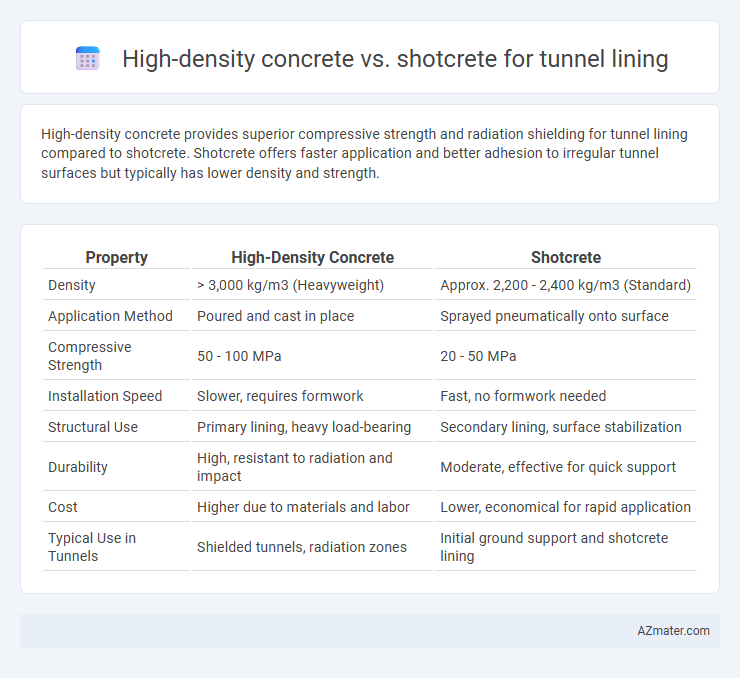High-density concrete provides superior compressive strength and radiation shielding for tunnel lining compared to shotcrete. Shotcrete offers faster application and better adhesion to irregular tunnel surfaces but typically has lower density and strength.
Table of Comparison
| Property | High-Density Concrete | Shotcrete |
|---|---|---|
| Density | > 3,000 kg/m3 (Heavyweight) | Approx. 2,200 - 2,400 kg/m3 (Standard) |
| Application Method | Poured and cast in place | Sprayed pneumatically onto surface |
| Compressive Strength | 50 - 100 MPa | 20 - 50 MPa |
| Installation Speed | Slower, requires formwork | Fast, no formwork needed |
| Structural Use | Primary lining, heavy load-bearing | Secondary lining, surface stabilization |
| Durability | High, resistant to radiation and impact | Moderate, effective for quick support |
| Cost | Higher due to materials and labor | Lower, economical for rapid application |
| Typical Use in Tunnels | Shielded tunnels, radiation zones | Initial ground support and shotcrete lining |
Overview of Tunnel Lining Techniques
High-density concrete and shotcrete are prominent tunnel lining techniques, each offering unique advantages in structural support and durability. High-density concrete provides superior strength and radiation shielding, making it ideal for tunnels requiring heavy load-bearing and protection from environmental factors. Shotcrete, applied pneumatically, ensures rapid installation with excellent adhesion to irregular surfaces, enhancing overall construction efficiency and flexibility in complex tunnel geometries.
What is High-Density Concrete?
High-density concrete is a specialized type of concrete formulated with heavy aggregates such as barite, magnetite, or hematite, providing a density significantly higher than standard concrete, typically around 3,800 to 4,800 kg/m3. This elevated density enhances its radiation shielding, load-bearing capacity, and durability, making it ideal for tunnel lining applications where high strength and protection against radiation or vibration are required. In comparison to shotcrete, which is sprayed concrete applied pneumatically, high-density concrete is conventionally cast and offers superior mass and structural integrity critical for demanding underground environments.
What is Shotcrete?
Shotcrete is a pneumatically applied concrete mixture sprayed onto surfaces at high velocity, commonly used for tunnel lining due to its excellent adhesion and rapid setting properties. It offers flexibility in application, conforming to complex shapes and enabling immediate support during excavation, which contrasts with high-density concrete that primarily focuses on enhanced weight and strength for radiation shielding or heavy load-bearing. Shotcrete's accelerated curing and adaptability make it a preferred choice in tunnel construction for reinforcing ground stability and preventing collapse.
Material Properties Comparison
High-density concrete offers superior compressive strength and enhanced gamma radiation shielding, making it ideal for tunnel linings requiring high durability and radiological protection. Shotcrete provides excellent adhesion and rapid application with reduced formwork costs, though its density and strength typically fall below that of high-density concrete. The choice between these materials depends on specific tunnel requirements such as load-bearing capacity, environmental exposure, and installation speed.
Installation Methods and Equipment
High-density concrete for tunnel lining is typically installed using conventional casting methods involving formwork and cranes, requiring heavy-duty concrete pumps to handle the material's increased weight and viscosity. Shotcrete application employs specialized spraying equipment, such as robotic arms or handheld pneumatic nozzles, enabling rapid placement and adhesion directly onto tunnel surfaces without extensive formwork. The choice of installation method impacts labor intensity, equipment costs, and application speed, with shotcrete offering flexible, efficient coverage ideal for complex geometries compared to the more controlled casting process used for high-density concrete.
Structural Performance in Tunnel Environments
High-density concrete offers superior structural performance in tunnel lining by providing enhanced radiation shielding and increased compressive strength, making it ideal for environments requiring heavy load resistance and durability. Shotcrete, applied pneumatically, ensures excellent adhesion to irregular tunnel surfaces, enabling rapid installation and effective reinforcement in complex geometries, although it generally exhibits lower density and strength compared to traditional cast high-density concrete. Tunnel environments demanding high load-bearing capacity and extended service life benefit from high-density concrete, whereas shotcrete is preferred for flexible, quick application and initial stabilization during excavation.
Durability and Lifespan Considerations
High-density concrete offers superior durability and a longer lifespan for tunnel lining due to its enhanced compressive strength and resistance to chemical attacks, making it ideal for harsh underground environments. Shotcrete provides excellent adhesion and rapid application, but may require additional reinforcement and maintenance to match the longevity of high-density concrete. Optimizing tunnel lining materials involves balancing durability factors such as abrasion resistance, permeability, and corrosion protection to ensure structural integrity over extended service periods.
Cost Analysis: High-Density Concrete vs Shotcrete
High-density concrete typically incurs higher material costs due to its specialized aggregates and additives, but offers long-term durability benefits for tunnel lining projects. Shotcrete, while generally more cost-effective in initial application and faster to apply, may require additional reinforcement and maintenance, influencing overall expenses. Evaluating total lifecycle costs, including labor, material, and maintenance, is essential to determine the most economical choice for tunnel lining.
Safety and Environmental Impact
High-density concrete offers enhanced radiation shielding and structural integrity for tunnel lining, reducing long-term environmental hazards through durability and minimized maintenance. Shotcrete allows rapid application and adapts to complex tunnel geometries, decreasing worker exposure to hazardous conditions and reducing construction waste by precise material placement. Both materials improve tunnel safety, but high-density concrete excels in contamination prevention while shotcrete optimizes environmental efficiency during installation.
Selection Criteria for Tunnel Lining Solutions
High-density concrete offers superior radiation shielding and durability, making it ideal for tunnels requiring enhanced structural strength and protection against radioactive environments. Shotcrete provides rapid application, excellent adhesion, and adaptability to irregular tunnel surfaces, facilitating faster construction and reduced formwork costs. Selection criteria for tunnel lining solutions should consider factors such as load-bearing capacity, environmental exposure, construction speed, and long-term maintenance requirements.

Infographic: High-density concrete vs Shotcrete for Tunnel lining
 azmater.com
azmater.com